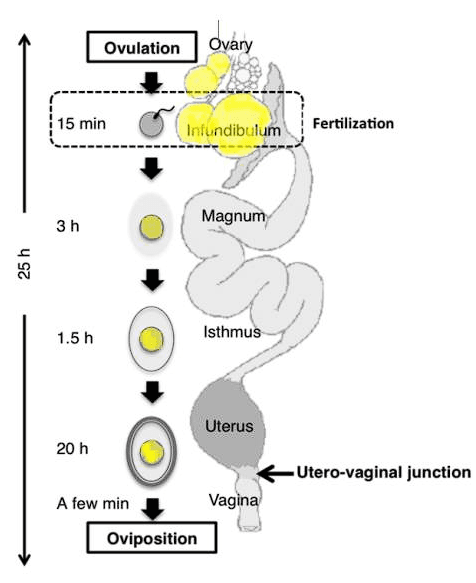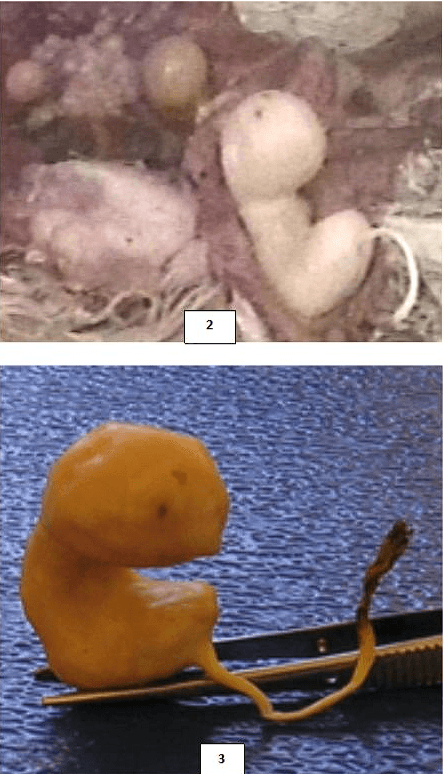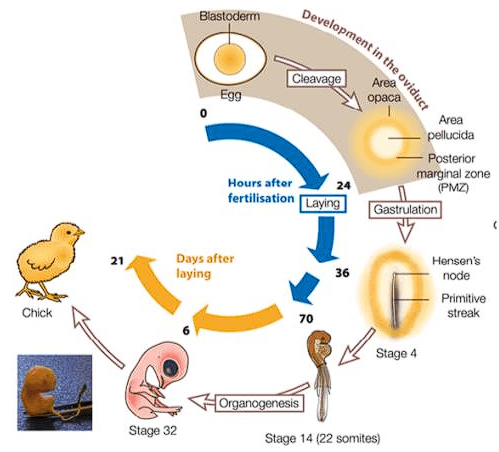The Pregnant Hen
Published: October 3, 2023
By: M. Eltigani Arif / College of Agricultural Science, Sudan University of Science & Technology.
As part of the practical section on poultry reproductive system anatomy for third-year students at the College of Agricultural Studies, Sudan University of Science and Technology, we procured a spent layer hen from a local market in Khartoum North. The objective of the dissection was to examine the reproductive system, which is composed of the ovary and the oviduct (Fig. 1).
The ovary is responsible for the development of ova or yolks. When an ovum has matured, it is released from the ovary into the oviduct, a twisted long tube that is 64 to 69 cm long. The oviduct is divided into five major sections, each with a specific function in the formation of the egg.
The funnel-shaped upper section of the oviduct is the infundibulum, which picks up the yolks dropped into the oviduct. The next section is the magnum, where the thick albumen forms. The isthmus is where the inner and outer shell membranes form, and the shell gland or uterus is where the shell forms on the egg. The last section the vagina, which is about 10 to 13 cm long, helps push the egg out of the hen's body.

Fig. 1 Reproductive Organs of the Hen (source: Sasanami et al. 2013)
To keep eggs about to be laid away from feces, the hen inverts her oviduct within the cloaca, a bulbous organ found at the end of the alimentary tract.
The blastodisc appears as more of a small, intense whitish spot on the surface of the yolk, contains a single female cell. If sperm is present when a yolk enters the infundibulum, fertilization occurs, and the blastodisc becomes a blastoderm, which is the true egg. The temperature to which the egg is exposed is the catalyst that initiates pre-oviposition embryonic development inside the oviduct and post-oviposition embryonic development inside the incubator.
Before starting the dissection of the spent layer hen, we observed that the bird stood in an upright position (penguin-like stance), walked with difficulty, and had abnormally long nails (as depicted in photo 1), a common issue in birds raised in battery cages without access to abrasive surfaces. Upon necropsy, we found around 10 yolks accumulating in the body cavity and a hard object in the uterus (Photos 2 and 3), resembling an embryo of 9 days of age in the incubator (Fig. 2).

Photo 1: Yolks Accumulation in the Abdominal Cavity & the 9 Days Old Embryo

Photo 2 and 3 The 9 Days Old Embryo

Fig 2: Daily Changes in the Weight and Form of the Developing Chick Embryo (White Leghorn)
Our explanation for this phenomenon is that the spent hen mated with a rooster while waiting for a customer in the local market, and the embryo developed inside the uterus is a fertile egg that remained inside for around 9 days (Fig. 3). The deep body temperature-initiated pre-oviposition embryonic development beyond the cleavage, gastrulation, and reached almost stage 24 of organogenesis according to Hamburger-Hamilton classification (Fig. 3).

Fig 3: Pre- and Post-Oviposition Embryonic Development
Adapted from ref. 149, Springer Nature Limited. (Springer International, 2019).
This phenomenon highlights the significant impact of the laying hen's deep body temperature on pre-oviposition development. In this case, the embryo reaches a more advanced stage than a typical one at the time of oviposition, which takes place 25 hours after fertilization (Fig. 1), and the blastoderm consists of approximately 60,000 cells.
Delay in passage of the egg during formation along the oviduct for more than 25 hours, will not stop the ovary from producing and ovulating yolks at a consistent rate. However, it seems that it inhibits the infundibulum's ability to search out and pick up these new yolks, and consequently, they accumulate in the body cavity faster than they can be reabsorbed. Such hens are known as "internal layers".
In a case more advanced than the case of our above-mentioned hen, the BBC revealed on 19 April 2012 a rare case of a hen in Sri Lanka that hatched a chick without laying an egg, challenging the old puzzle of whether the chicken or the egg came first. The hen kept the egg inside her body for 21 days and the chick was born inside her. The hen did not survive the process and a post-mortem showed that she had internal injuries. This unusual event made news in Sri Lanka, where the Sri Lankan Daily Mirror concluded: “The chicken came first; not the egg”.
Conclusion
1. Delay in passage of the egg during formation along the oviduct for more than 25 hours, will not stop the ovary from producing and ovulating yolks at a consistent rate. But it appears to inhibit the infundibulum's ability to search out and engulf these new yolks.
2. It seems that the delay in the passage of an egg during formation is the main cause of the internal layer phenomenon.
Related topics:
Authors:
Recommend
Comment
Share

Would you like to discuss another topic? Create a new post to engage with experts in the community.








.jpg&w=3840&q=75)